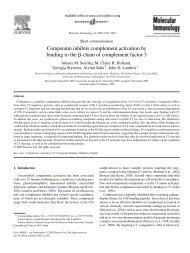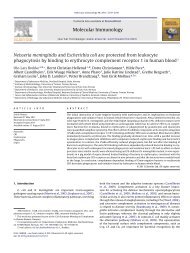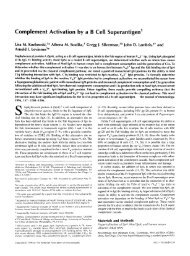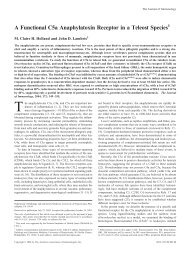C5aR-Antagonist Significantly Reduces the ... - John D. Lambris
C5aR-Antagonist Significantly Reduces the ... - John D. Lambris
C5aR-Antagonist Significantly Reduces the ... - John D. Lambris
You also want an ePaper? Increase the reach of your titles
YUMPU automatically turns print PDFs into web optimized ePapers that Google loves.
4 RECKNAGEL ET AL.<br />
Table 2. Number of Bridged Cortices of <strong>the</strong> Calli Evaluated by m-Computed Tomography in Two Planes of Rats<br />
without (Control) or with Treatment with a <strong>C5aR</strong>-<strong>Antagonist</strong><br />
Group<br />
Number of Bridged Cortices<br />
0 1 2 3 4 Group<br />
Not Healed Healed<br />
<strong>C5aR</strong>-antagonist treated group. The radiological and<br />
histological results revealed that <strong>the</strong> predominant<br />
tissue in <strong>the</strong> fracture callus in both groups was newly<br />
formed bone, indicating that <strong>the</strong> healing process had<br />
widely progressed after a period of 35 days. Never<strong>the</strong>less,<br />
<strong>the</strong> differences between <strong>the</strong> <strong>C5aR</strong>-antagonist<br />
treated and <strong>the</strong> control group in <strong>the</strong> biomechanical<br />
outcome were still considerable. In ongoing studies<br />
earlier investigation time points are included to evaluate<br />
differences in callus composition during <strong>the</strong> course<br />
of healing.<br />
At present little is known about <strong>the</strong> role of C5a in<br />
fracture healing. It is well known that complement is<br />
locally activated after tissue injury, and is important<br />
for an adequate and effective inflammation, for example,<br />
by increasing vascular permeability, recruitment<br />
of leukocytes, lymphocyte activation, opsonization of<br />
pathogens, and clearance of necrotic and apoptotic<br />
tissues at <strong>the</strong> site of injury. 27,28 Local activation of<br />
complement might, <strong>the</strong>refore, play an essential role in<br />
bone regeneration, especially in <strong>the</strong> fracture hematoma<br />
and <strong>the</strong> early stages of bone healing where inflammatory<br />
cells are predominant. 29,30 This was confirmed<br />
by a recent study of our group demonstrating that<br />
<strong>C5aR</strong> was abundantly expressed by <strong>the</strong>se cells, but<br />
intriguingly also by osteoblasts, chondroblasts, and<br />
osteoclasts in zones of intramembranous and enchondral<br />
ossification. 15 This suggests that C5a may be essential<br />
for regular regeneration processes during all stages of<br />
fracture healing.<br />
After a blunt chest trauma systemic C5a is increased<br />
very rapidly and transiently. 1 Accordingly, we applied<br />
<strong>the</strong> <strong>C5aR</strong>-antagonist during <strong>the</strong> first hours after <strong>the</strong><br />
blunt chest trauma and were able to significantly<br />
improve <strong>the</strong> fracture healing outcome after 35 days,<br />
indicating that C5a triggers determining effects in <strong>the</strong><br />
very early healing phase. Systemically generated C5a<br />
causes a cascade of events, which could interact in<br />
several ways with <strong>the</strong> local fine-tuned inflammatory<br />
balance of bone healing. Because C5a activates <strong>the</strong> endo<strong>the</strong>lium<br />
and enhances cell migration, 1,31,32 it may<br />
increase <strong>the</strong> number of inflammatory cells, such as<br />
macrophages and polymorphnuclear neutrophils in <strong>the</strong><br />
fracture hematoma. C5a influences <strong>the</strong> function of<br />
leukocytes by inducing cytokine release as well as<br />
<strong>the</strong> production of proteases and reactive oxygen<br />
species. 33,34 This was confirmed by Flierl et al. 1 in<br />
<strong>the</strong>ir rat model of blunt chest trauma. An increased<br />
number and changed activity of neutrophils could,<br />
<strong>the</strong>refore, enhance and/or prolong <strong>the</strong> inflammatory<br />
phase of fracture healing. This was confirmed by studies<br />
reporting improved fracture healing after <strong>the</strong> depletion<br />
of neutrophils 35 or disturbed healing by <strong>the</strong><br />
application of zymosan, which stimulates <strong>the</strong> generation<br />
of reactive oxygen species by leukocytes. 36 C5a<br />
can prime macrophages to a more pro-inflammatory<br />
phenotype, leading to an increased secretion of cytokines<br />
in response to a second inflammatory stimulus. 34<br />
An increased release of inflammatory cytokines from<br />
macrophages has been shown to provoke delayed fracture<br />
healing. 37 Fur<strong>the</strong>rmore, C5a could act as a potent<br />
inhibitor of angiogenesis by pushing macrophages<br />
towards an angiogenesis-inhibitory phenotype, 22<br />
<strong>the</strong>refore possibly generating negative effects on bone<br />
regeneration. C5a might not only influence inflammatory<br />
cells but also osteoblast progenitors and osteoblasts<br />
as well as osteoclasts. It is a chemotactic factor<br />
for mesenchymal stem cells and osteoblasts, suggesting<br />
that it may modulate <strong>the</strong> recruitment of <strong>the</strong>se cells<br />
to <strong>the</strong> site of injury. 15,38<br />
Clinical Fracture Healing Outcome<br />
Control 1 2 0 0 5 Control 3 5<br />
<strong>C5aR</strong>-antagonist 0 0 0 1 7 <strong>C5aR</strong>-antagonist 0 8<br />
Figure 2. Absolute amounts of osseous tissue (TOT), cartilage<br />
tissue (Cg) and fibrous tissue (FT) within <strong>the</strong> callus of rats<br />
without (Ctrl) or with treatment with a <strong>C5aR</strong>-antagonist.<br />
JOURNAL OF ORTHOPAEDIC RESEARCH 2011<br />
It was reported that<br />
osteoblast-like osteosarcoma cells (MG-63) expressed<br />
functional <strong>C5aR</strong> and responded to C5a by releasing<br />
IL-6. 16 C5a appears also to increase osteoclast formation<br />
directly by binding to <strong>C5aR</strong> on osteoclast precursorsor<br />
and indirectly by increasing <strong>the</strong> expression of<br />
receptor activator of nuclear factor-kB (RANKL) and<br />
IL-6 in osteoblasts, 17 which could in turn stimulate










